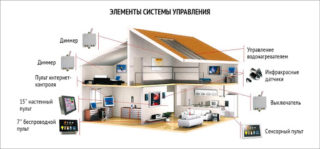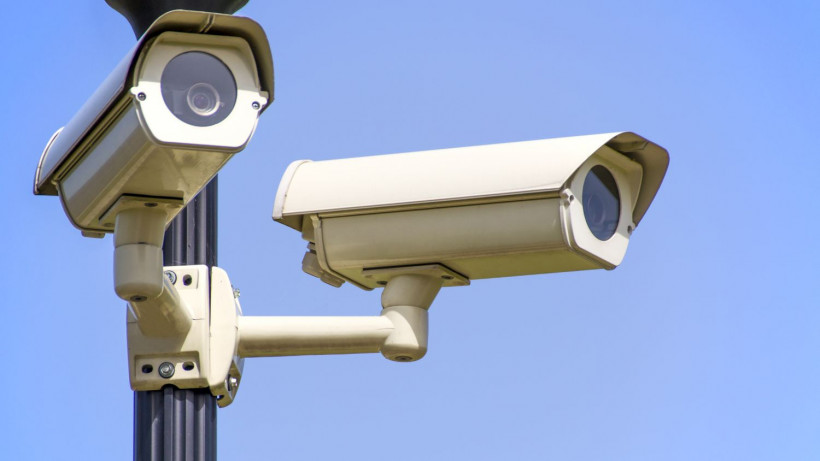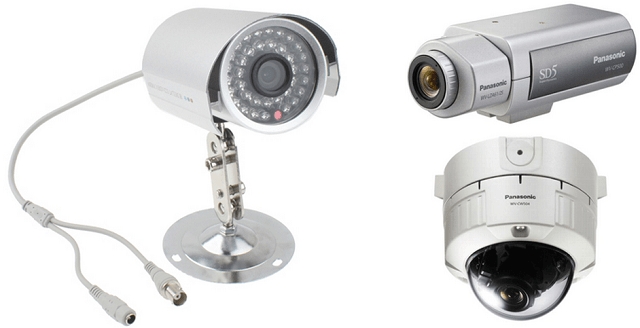Creating a “smart home” system with your own hands will allow you to automate many functions and save a lot on the work of specialists. It takes a lot of effort to establish a functional and practical design. The correct choice of equipment and a competent approach will allow you to cope with this difficult but interesting task.
Definition of a smart home system
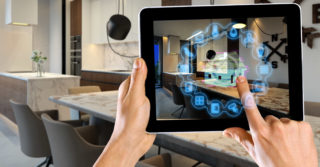
In modern housing, there are many household appliances and appliances for various purposes, size and power. Turning them on, off, and configuring them takes a lot of time and sometimes effort.
When creating a smart apartment, you can control all devices from one remote control, while in the room or remotely. All equipment is conventionally divided into subcategories that have common properties, purpose and control method. The guidance is carried out with the help of computer hardware and software, the installation of which can also be done independently.
Varieties and characteristics
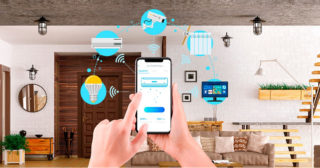
To create a smart home with your own hands, you can choose a scheme for which you have enough money or skill.
Varieties of connecting household appliances and appliances:
- Separately. It is assumed that the groups of devices are grouped into blocks according to their specifics. For example, general control can be carried out by heating, lighting, air conditioning, ventilation, humidification and dehumidification, security, video and audio systems. All units have their own consoles, their number is not limited.
- All in one. Here, all structures and devices available in the house are displayed on a common control panel, which is a kind of server for one building. In most cases, this is a powerful system unit with a display. To make managing devices more convenient, several portable devices are synchronized with the server. These can be tablets, laptops or smartphones of the corresponding power.
Communication of devices, controls to the central processor is carried out by wires or over wireless networks. The most popular synchronization method is the Internet, which provides remote control of the system from anywhere in the world.
Advantages and disadvantages of a multifunctional system
The main advantages of this technology:
- Saving time and effort, which are usually spent on walking around the house, looking for controls, making frequent adjustments and adjustments.
- Guaranteed to create an optimal level of comfort. Electronics maintains the specified parameters of the indoor microclimate - temperature, humidity, air purity. All this has a positive effect on people's health and their quality of life.
- High level of security. Owners of immovable property are not in danger of injury due to walking along dark corridors and garden paths, as the light turns on on its own. Automation switches off devices when there is a danger of critical overloads.
- Saving resources.Exactly as much water and electricity is consumed as needed to meet the needs of property owners.
There is only one drawback - the amount of initial investment. In addition, self-installation will require mental effort and waste of time.
Smart home elements
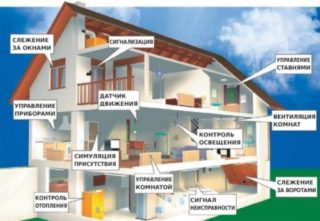
The Smart Home system consists of several blocks, which combine products working on the same principle.
- Heating, ventilation and air conditioning (HVAC). A unit of these structures is responsible for maintaining the optimal ratio of temperature, humidity, composition and filtration of polluted air in the premises. The system works separately from the rest of the nodes, there is a possibility of duplicating devices in case of failure of one of them.
- Lighting. For home improvement, automatic lamps, sockets, switches and dimmers are used. Using remote access, the devices are activated, configured and turned off. Lighting can include seismic, volumetric, infrared and ultrasonic sensors.
- Audio-visual. The comfort of living in a building is inextricably associated with watching news, films, TV series and listening to music. The central server hosts controls for audio and video devices, color music, internal and external alarms.
The heart of the system is a power source that can keep it running for 6-12 hours. Depending on the number and power of consumers, powerful high-capacity batteries or an automatic generator can be installed. Alternatively, a wind farm.
Preparatory work and step by step instructions
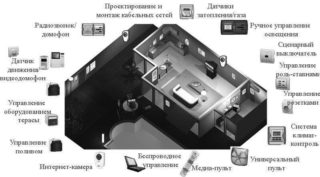
The preparatory phase is the most difficult. It consists in drawing up a competent project, where all the nuances must be taken into account. After that, you need to purchase equipment, materials and tools.
Step-by-step instructions for installing a home automation system:
- Marking.
- Installation of control devices - motors, drives, lifts.
- Installation of system elements - control panel, sensors, lamps, sockets, underfloor heating, household appliances and appliances.
- Connection of installed equipment into a single network.
In conclusion, a step-by-step synchronization of the nodes is carried out, adjustment, calibration and testing of the system in all modes.
Features of installation in a private house and in an apartment
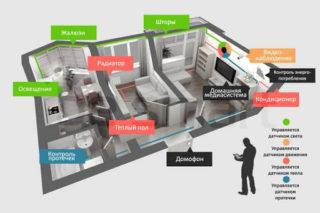
It is much easier, faster and cheaper to develop and deliver autonomous control of the functions of household appliances in an apartment than in a private house.
In the apartment, the scope of use of electronics is limited to lighting, water supply, audio visual devices and electrical heating. In this case, one should remember about the inadmissibility of installing a water floor, as well as about the power of the network, which must have a proper margin.
Private real estate is much more difficult. The owner must take care of alarm, street lighting, heating of gutters, sewerage and plumbing. We must not forget about the electric drive to the gate and wicket.
Control elements
There are such options for managing devices:
- Voice. It is carried out using the submission of speech commands. Their list and the number of owners are entered into the computer memory at the programming stage after the installation of the elements.
- Manual. Control is carried out by pressing mechanical buttons on the remote control or by manipulating the touch screen.
Both methods have their pros, cons and roughly the same installation cost.
The budget option for making a smart home is the purchase and assembly of the following elements into a single network:
- controllers;
- main processor;
- sensors;
- electric motors;
- boards;
- buttons;
- control panels.
Depending on the number of devices and options, arranging a smart home with your own hands will cost the master 8000-25000 rubles.
For those who are not good at electronics, there are ready-made solutions: Xiaomi Smart Home Suite, Arduino, Aqara Smart Light Control, Google Home and Amazon Echo.


